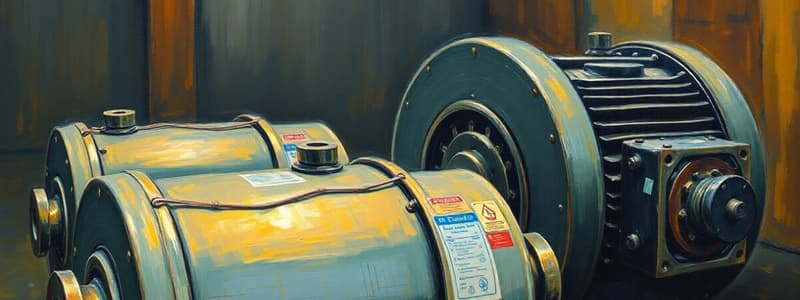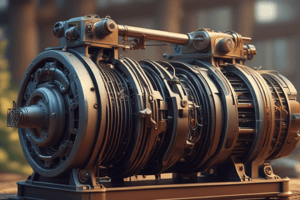Podcast
Questions and Answers
What type of motor runs at synchronous speed?
What type of motor runs at synchronous speed?
- Stepper motor
- Synchronous motor (correct)
- Universal motor
- Induction motor
Which part of a synchronous motor contains a winding that is connected to a DC power source?
Which part of a synchronous motor contains a winding that is connected to a DC power source?
- Rotor (correct)
- Stator
- Exciter
- Slip-rings
What is the role of the exciter in a synchronous motor?
What is the role of the exciter in a synchronous motor?
- To generate AC power from DC
- To provide a DC supply to the rotor (correct)
- To act as a cooling system
- To control the speed of the stator
Which of the following is NOT a characteristic of synchronous motors?
Which of the following is NOT a characteristic of synchronous motors?
What is the primary difference between synchronous and asynchronous motors?
What is the primary difference between synchronous and asynchronous motors?
What component enables the DC supply to be fed to the rotor winding?
What component enables the DC supply to be fed to the rotor winding?
Which type of synchronous motor does NOT require excitation?
Which type of synchronous motor does NOT require excitation?
Which feature is crucial for the operation of a synchronous motor?
Which feature is crucial for the operation of a synchronous motor?
In what applications are synchronous motors commonly used?
In what applications are synchronous motors commonly used?
What material is typically used for the stator of a synchronous motor?
What material is typically used for the stator of a synchronous motor?
What is the first stage in the working of a synchronous motor?
What is the first stage in the working of a synchronous motor?
Which statement reflects the reason why a synchronous motor is not self-starting?
Which statement reflects the reason why a synchronous motor is not self-starting?
What happens to the rotor poles during the operation of a synchronous motor?
What happens to the rotor poles during the operation of a synchronous motor?
Which starting method for synchronous motors helps reduce inrush current during start-up?
Which starting method for synchronous motors helps reduce inrush current during start-up?
What is one of the main advantages of using a synchronous motor?
What is one of the main advantages of using a synchronous motor?
What is the significance of the power angle in the torque equation of a synchronous motor?
What is the significance of the power angle in the torque equation of a synchronous motor?
What is one disadvantage of synchronous motors?
What is one disadvantage of synchronous motors?
In a cylindrical rotor synchronous motor, what does the torque equation indicate?
In a cylindrical rotor synchronous motor, what does the torque equation indicate?
What is a V-curve in the context of a synchronous motor?
What is a V-curve in the context of a synchronous motor?
How does the power factor change when excitation increases in a synchronous motor?
How does the power factor change when excitation increases in a synchronous motor?
What does the power angle in a synchronous motor signify?
What does the power angle in a synchronous motor signify?
What happens to the torque produced by a synchronous motor when the power angle is at 90 degrees?
What happens to the torque produced by a synchronous motor when the power angle is at 90 degrees?
What occurs if the power angle exceeds ±30 degrees in a synchronous motor?
What occurs if the power angle exceeds ±30 degrees in a synchronous motor?
What does the term 'pull-out torque' refer to in a synchronous motor?
What does the term 'pull-out torque' refer to in a synchronous motor?
Which of the following describes the shape of the V curves of a synchronous motor?
Which of the following describes the shape of the V curves of a synchronous motor?
How can the power factor of a synchronous motor be controlled?
How can the power factor of a synchronous motor be controlled?
What happens when the synchronous motor is over-excited?
What happens when the synchronous motor is over-excited?
Which parameter is primarily used to ensure the constant air gap flux in a synchronous motor?
Which parameter is primarily used to ensure the constant air gap flux in a synchronous motor?
What is the primary purpose of using an auto-transformer with a synchronous motor?
What is the primary purpose of using an auto-transformer with a synchronous motor?
Flashcards are hidden until you start studying
Study Notes
Synchronous Motor
- A synchronous motor is an electric motor that operates at a synchronous speed, converting electrical energy into rotational power.
- Synchronous Motors run at a speed directly proportional to the frequency of the AC power supply.
- Synchronous motors differ from asynchronous motors in their ability to operate at the synchronous speed.
- Synchronous motors are categorized into two types: Non-excited and Excited Synchronous Motors.
- Non-excited synchronous motors have rotors that align with the stator's magnetic field, driving the motor's rotation.
- Excited synchronous motors have an external DC power source that energizes the rotor field, causing rotation.
Construction and Components
- The stator is the stationary part, typically made of silicon-steel laminations with internal slots.
- The stator winding is a 3-phase winding (star or delta-connected) made of copper wire, placed in the stator slots.
- The rotor is the rotating part, made of silicon-steel laminations.
- Rotor winding is an enameled copper winding placed on the rotor poles, energized by a DC exciter.
- The exciter is a small DC generator mounted on the same shaft as the rotor, providing DC current to the rotor winding.
- Slip-rings and brushes facilitate electrical contact between the stationary exciter and the rotating rotor winding.
Working Principle
- When a 3-phase supply is applied to the stator winding, a rotating magnetic field is generated.
- The rotor poles are energized by the DC exciter, creating magnetic poles.
- The interaction of the stator's rotating magnetic field and the rotor's magnetic poles creates a torque that drives the rotor.
- The rotor rotates at the same speed as the stator's rotating magnetic field (synchronous speed).
- Synchronous motors are not self-starting because they don't produce a starting torque.
Advantages
- Power factor control: By adjusting the excitation, the power factor can be controlled (leading, lagging, or unity).
- Power factor correction: Can be used to improve the overall power factor of a system.
- High efficiency: Generally, higher efficiency compared to induction motors, especially in low-speed applications.
- Stable mechanical operation: Wider air gap allows for greater mechanical stability.
Disadvantages
- No self-starting: Requires additional starting methods.
- Requires external DC excitation: Complicates the system and may need maintenance.
- Susceptible to hunting: Sudden load changes can cause instability and oscillation of the rotor (hunting) due to inertia.
Starting Methods
- Direct Online (DOL) Starting: Directly connecting the motor to the power supply. Suitable for small motors with low starting torque requirements.
- Autotransformer Starting: Utilizing an autotransformer to reduce the starting voltage. Enables smooth acceleration.
- Rotor Resistance Starting: Adding resistors in series with the rotor windings. Offers adjustable starting torque.
- Soft Starters and Variable Frequency Drives (VFDs): Electronic devices that gradually increase voltage and frequency, reducing starting current and stress.
- The choice of starting method depends on the motor size, application requirements, and desired performance.
Torque Equation of Synchronous Motor
- The equation calculates the torque developed by a synchronous motor: T = (3/2) * (Es * V / Xs) * sin(?)
- Where:
- T is the developed torque
- Es is the synchronous reactance voltage per phase
- V is the terminal voltage per phase
- Xs is the synchronous reactance per phase
- ? is the power angle
V-curve and Inverted V-curve
- V-curve represents the relationship between field excitation and power factor, keeping torque constant.
- At low excitation, the power factor is low (over-excited, leading power factor).
- As excitation increases, the power factor improves, reaching unity power factor.
- Further increasing excitation beyond the optimum point leads to under-excited (lagging power factor).
- Inverted V-curve shows the inverse relationship between field current and power factor, reflecting the V-curve for power factor.
Power Angle Characteristics
- Power angle (?) is the angle between the stator magnetic field and the rotor magnetic field.
- It determines the rotor's relative position with respect to the rotating stator field.
- Torque is proportional to sin(?), with maximum torque occurring when ? = 90°.
- Synchronous motors operate within a limited power angle range for stable operation (typically ±20° to ±30°).
- Pull-out torque is the maximum torque a synchronous motor can produce before losing synchronism.
- The power angle is important for power system stability, load management, and variable speed drive applications.
Applications
- Power generation plants: Used as synchronous condensers for power factor correction and voltage regulation.
- Industrial applications: Used in pumps, compressors, mills, and heavy machinery.
- Consumer electronics: Found in clocks, turntables, and other appliances.
- Other applications: Used in electric vehicles, wind turbines, and other specialized applications.
Studying That Suits You
Use AI to generate personalized quizzes and flashcards to suit your learning preferences.




